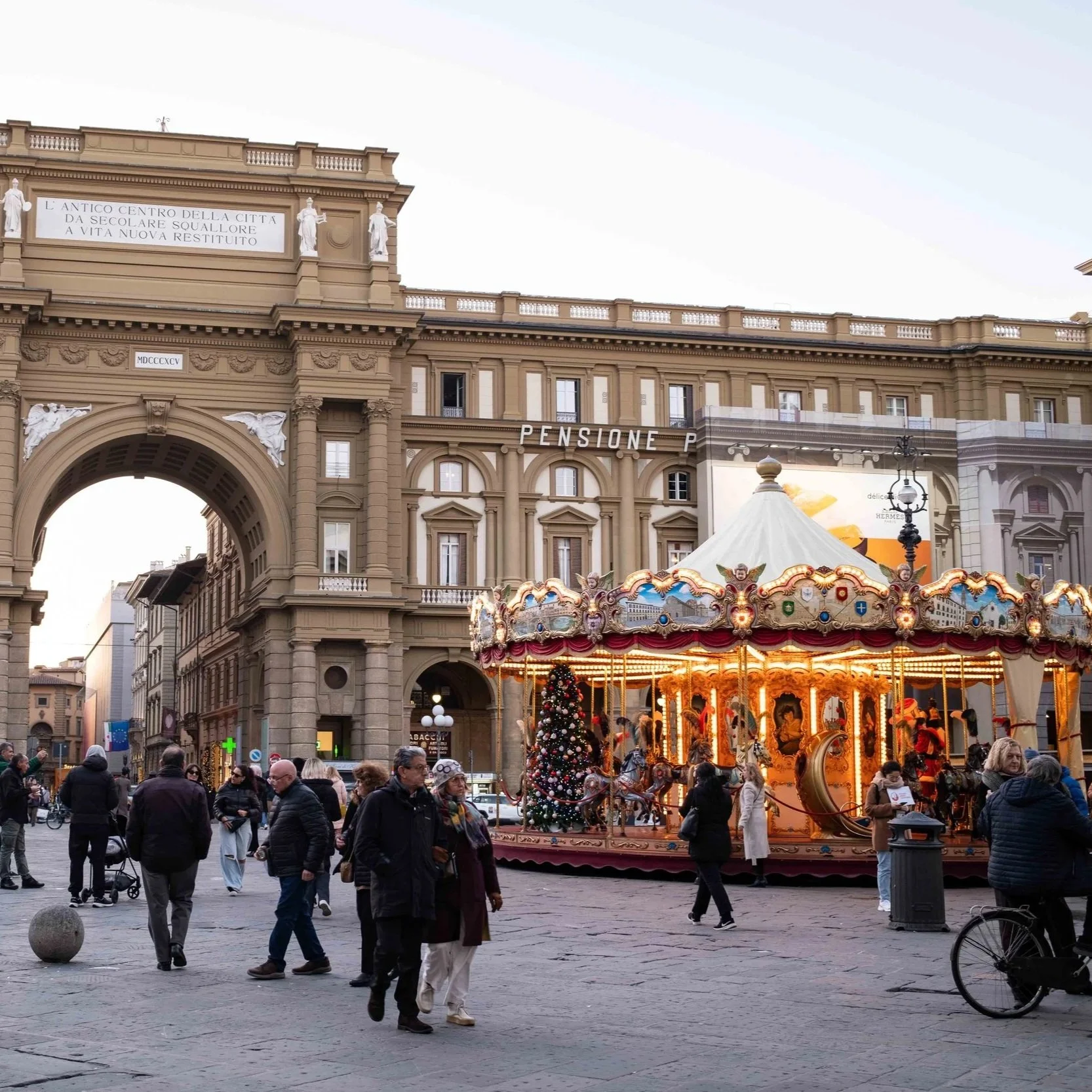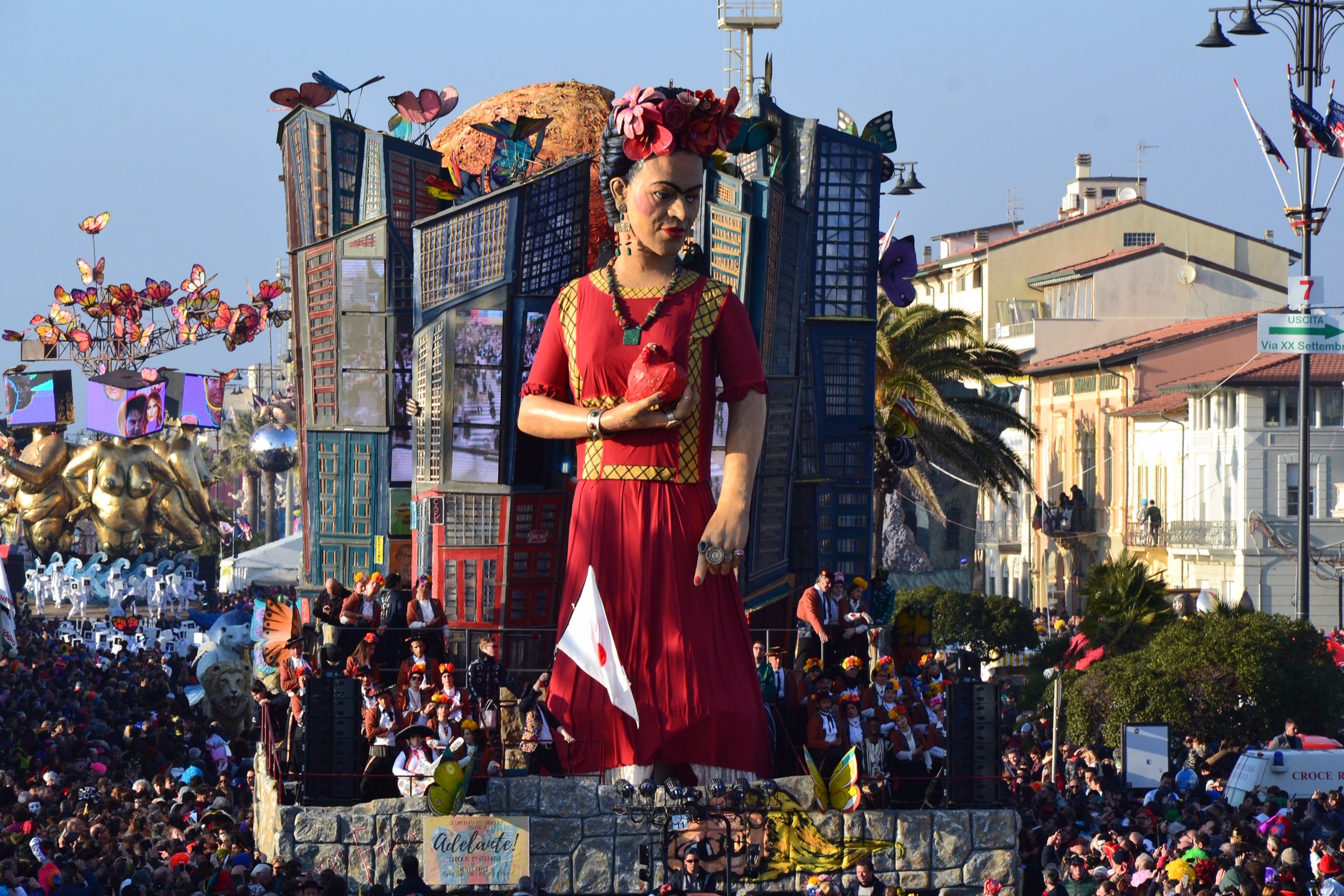Updated for 2026
Florence in summer is peak season for a reason, but it’s honestly one of our least suggested time to visit. In fact, if you’re looking to experience Florence life and less of your fellow tourists, winter might actually be a better time to visit… especially if you’re keen to save some euros.
A lot of Tuscans return home for the holidays and are swapped with Italian and European visitors. The city comes alive in the lead up to Christmas and New Year with beautifully illuminated streets, outdoor performances, holiday food tours and chestnuts stands and new wine (vino novello) at various nooks!
So if you’re tempted to visit, but just need a little more convincing before you press book, this is our guide to the best things to see, do and eat in Florence in winter- both during and post holidays plus winter food specialties to be on the lookout for
Our top 3 reasons to visit Florence in winter
Less tourists: November to March is low season for Florence, which means it’s your best chance to experience local life without the crowds. There tend to be more Italian and European travelers, for sure though so not entirely “tourist-free.”
Competitive accommodation: Accommodation rates take a dip during these months in Florence, as there is less demand and more options in the center and the outskirts.
Sale season: January in Italy is the sale season, so you can take advantage of this and do some shopping. After all, you’re saving on flights and accommodation, so why not splurge?
Winter foods! Italy is blessed with a biodiverse year-round growing seasons as well as religious periods like Christmas and Carnevale leading up to the Easter holidays to herald in a plethora of both seasonal vegetables and festive delicacies. Think carciofi (artichokes) and zucca (squash) heavy stews and ribollita soups to warm the soul in-between museum hunting. For more on seasonal eating, read up on this guide Coral wrote for the Michelin Guide on what to eat when you visit.
What to expect weather-wise
Florence enjoys a transitional Mediterranean climate throughout the year which means it is one of the milder European cities during winter months. The sun is shines for many days and the average day time temperatures range between upper 40’s and low 50s°F, while it goes down in the 30’s and 40’s at night.
Florence is still a humid city so the temps tend to feel cold to the bone. Rainfall is more common, January and March tend to be the rainiest and there are very rare forecasts of snow. February strangely tends to be hit or miss year to year with sunny skies and mild temps. No need to pack for the bitter cold but definitely come prepared to bundle up, especially since powerful heating indoors is not a thing.
What to pack
Come well prepared for the fickle winter weather in Florence with waterproof layers and comfy, warm shoes. Although snow is unlikely, it might rain during your trip. A warm and waterproof winter coat as well as an umbrella are musts. Scarves, gloves, and hats will also keep you warm while you explore.
Top things to see and do in Florence in winter
Museums!
There are a lot of obvious suspects for museums in Florence, but we love to recommend these lesser-known gems as well:
Casa Buonarroti, Palazzo Davanzati, Ferragamo’s fashion museum, Museo degli Innoccenti. This post details booking museums plus where to eat nearby.
Do a food tour!
We offer festive dinner crawls and aperitivo tours on Christmas Eve and New Year’s Eve. Check out this post to get a taste of what we normally do and book our dinner crawl or our Aperitivo cocktail & snack tour. Festive menus aren’t listed on the tour page but rest assured we have a pop-up menu full of traditional Italian holiday dishes planned! Beyond the holidays, they make for something fun to do and guarantee you a toasty table full of local specialties.
Visit Pitti Palace and Boboli
Of course, museums and galleries are the go-to in winter, but if you feel like something outdoors, hit up the Medici’s favorite personal giardini (gardens), Boboli (Piazza de' Pitti, 1; Every day). Directly behind Pitti Palace, these Italian gardens influenced the tone for many European courts and is populated by ancient and Renaissance statues.
Check out emerging artists at MAD
The Murate Art District (MAD) has a great line-up of independent artists and exhibits, and is a really cool space near Sant’Ambrogio’s daily market.
Visit Florence on Ice Village
Located in Fortezza da Basso near the main rail station, this winter wonderland features Europe’s longest rink, pop-up markets and an array of festive food stands. From ice-skating to aperitivi, this park is the perfect spot to get your winter fix without trekking far from Florence’s historic center. Details on their IG also in English.
Check out Florence Lights Up
Florence Lights Up involves a number of monuments and iconic locations around the city decorated in light displays. Among these is a video projection on the Ponte Vecchio. The city’s famous churches and towers are colourfully rendered throughout the month, making Florence even more beautiful through its winter nights.
Head to the Theatre
Teatro della Toscana (aka la Pergola) hosts various theatric shows with rotating events calendar every month, like Pinocchio or The Nutcracker. pend a few hours watching one of the world’s most famous and beloved ballets in one of the most beautiful theatres of Italy.
Christmas and monthly artisans markets
The biggest Christmas Market in Florence is held in Piazza Santa Croce, where you can find everything from handmade crafts to food products. A little gimmicky, we much prefer to suggest La Fierucola’s monthly and weekly markets. This is a slow food artisanal market that pops up around select squares. Think small farmers, beekeepers, oil producers, cheese makers, bakers, ceramicists & other artisans who follow slow-food, organic and traditional practices. Their schedule HERE.
Also check out the Fierucola dell'Immacolata (December 8th in Piazza Santissima Annunziata) and Fierucolina di Natale (December 16th in Piazza Santo Spirito) for the best kind of holiday gift shopping!
Chantilly al Panettone gelato, naturally!
Top things to eat in Florence in Winter
To take in Florence’s downtown key sights with hidden gem foodie stops tasting festive specialties, sign-up for our Historic Food Lover’s Tour
Stay warm, discover seasonal dishes and eat around town at our favorite restaurants in Florence on our Progressive Dining Crawl
Make sure to bookmark our Wine & Dine Ideas for Christmas and New Years Florence and my Where to eat in Florence on Christmas Eve/Day guide.
Hot chocolate
Hot chocolate is a Florentine tradition. It first appeared at the Medici court in the 16th century and the city’s nobles fell instantly in love, serving it instead of wine at meals in Palazzo Pitti. When the weather cools even the slightest, cravings hit for cioccolata calda or Italian hot chocolate. Unlike the drink you might find in other countries, the Italian version of this classic is made has an almost pudding-like texture and is served in tiny cups or glasses. Here are our favorite places to enjoy Italian hot chocolate in Florence.
Caldarroste
Nicknamed ‘caldarroste’ in Italian, roasted chestnuts are a great segue in the series of seasonal classics. Traditionally, caldarroste are fire-roasted in a holed pan before being wrapped up in a butcher paper cone and enjoyed piping hot as you stroll through the city. During winter months, caldarroste stands line the major shopping streets of Italian cities, luring residents and tourists alike with the warm, toasty aroma of the roasting chestnuts.
Photo by Michael Zee of Symmetry Breakfast
Ribollita
The word ribollita translates from the Italian to "reboiled," as this soup was typically made by reboiling leftover bean and vegetable soups the next day, adding bits of stale bread for a thicker and more filling stew. The three main ingredients always found in any variation of ribollita are stale bread, homemade broth, and cooked beans. Despite its humble beginnings, every restaurant in Tuscany seems to have its own version of this soup on the menu.
Cotechino and lenticchie (lentils)
Cotechino, also Zampone is a type of cooked down pork bits (the good stuff) and rind, spiced with what seems like Christmas mulled wine (nutmeg, cinnamon, wine etc) and then formed in a tube and sliced. It is served with lentils because they are thought to resemble “coins” thus bringing prosperous luck to the New Year. Check out more recipe for making this traditional dish at home!
Panettone
A Christmas without panettone is barely a Christmas in Italy. Its name simply means “large loaf of bread”. Light, fragrant and pleasantly rich, panettone tradizionale is a sweet, leavened cake, usually filled with raisins and candied fruits. Modern variations also include chocolate and pistachio! Panettone is traditionally eaten on Christmas Day with Moscato d’Asti, a crisp and often sweet sparkling white wine made from the Moscato bianco grape and produced mainly in the province of Asti, in northern Italy.
Punch (or as the locals call it, Ponch)
Tuscany has two main types on Ponch worth trying: Ponch al Mandarino is pure, orange-flavored liqueur with an aroma so spicy and intense, it will literally tickle your nostrils. Ponch alla Livornese is a powerful kick of rum, coffee, lemon, cinnamon and sugar. Both are served piping hot in little glass mugs.
While if you’re looking for somewhere cozy to hunker down on a cold winter’s evening, check out our guide to the best enotecas in Florence.
Where to attend a traditional Christmas service in Florence
From 8 December, you can catch a life-size nativity scene, made entirely with terracotta figures, in the Piazza del Duomo. It’s one of many nativity scenes you’re likely to see around the city and obviously just the start of the religious festivities held in the city around this time.
If you do wish to attend a traditional Christmas service while in the city, head to the Duomo for midnight Mass in Italian on Christmas Eve! As entrance to the mass is on a first-come, first-served basis, we recommend arriving before 10:30pm to ensure a spot.
Want to experience the Christmas Mass in English, instead? Head to St. Mark’s or St. James (both holding midnight Masses at 11pm), complete with joyful music. San Miniato Abbey, open for a mass with Gregorian chant: 24/12 midnight.
Keep in mind that, outside of the hours when Mass is being held, Florence’s churches are mainly closed on Christmas Day. At the Duomo, the entrance to climbing the dome is closed on both Christmas Day and December 26.
A float from the 2019 Viareggio Carnival. Photo from Wikipedia.
After the Christmas holidays, we have Carnival to look forward to!
As soon as panettone starts to fade, Carnival sweets start to appear at Florence’s most traditional bakeries. Think fried rice fritters, crispy sweet dough ribbons and chantilly stuffed schiacciata alla Fiorentina orange-scented cakes. This post details the must-have Carnival sweets and where to find them. Take a specialty food tour like our Market Tour to be taken behind the scenes to neighborhood bakeries and farmer-run food stands to get a true taste of what’s in season.
Day trip detour
Viareggio
Viareggio Carnival is one of Italy’s most spectacular Carnival parades and floats. It’s only an hour from Florence and well worth the trip. The highlight of every carnival is the parade of gigantic floats. Made out of papier-mache, they are known for their irreverent political satire and social commentary, but also for their sheer size with some stretching as high as 30 metres!














